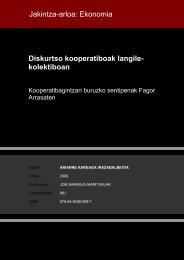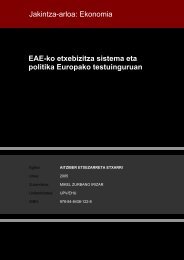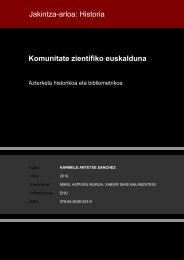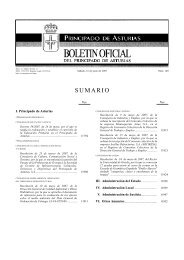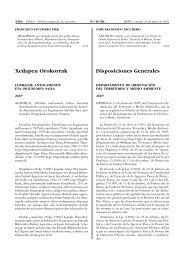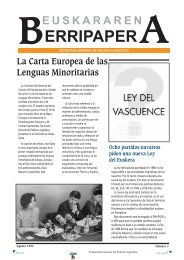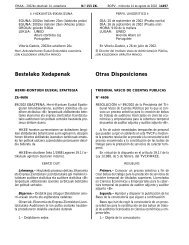MOLUSKUEN LISERI-GURUINEKO EPITELIOAREN ... - Euskara
MOLUSKUEN LISERI-GURUINEKO EPITELIOAREN ... - Euskara
MOLUSKUEN LISERI-GURUINEKO EPITELIOAREN ... - Euskara
You also want an ePaper? Increase the reach of your titles
YUMPU automatically turns print PDFs into web optimized ePapers that Google loves.
Emaitzak eta eztabaida<br />
Cell-type replacement in the digestive gland of mussels exposed to<br />
pollutants<br />
Abstract: The digestive gland epithelium of the mussel Mytilus galloprovincialis (Lmk) is comprised of<br />
two cell types, namely digestive and basophilic cells. Under normal circumstances digestive cells<br />
outnumber basophilic cells but under the influence of pollutants a relative increase in the proportion of<br />
basophilic cells has been described. This alteration has been termed cell-type replacement (CTR).<br />
Autometallography (AMG) is a sensitive histochemical technique to localize metals in cells as black silver<br />
deposits (BSD) and has been used in the assessment of environmental metal pollution. BSD are localized<br />
in the digestive cells lysosomes. The objectives of this work are three. First, to know whether pollutants such<br />
as Cd were able to induce CTR. Second, to check wether Cd localization revealed by AMG at the<br />
ultrastructural level were cell-specific and, if so, to determine wether CTR influenced the estimations made<br />
by AMG. Finally, to determine the effective concentration of various pollutants to provoke CTR and to check<br />
wether CTR is reversible. For these purposes mussels were exposed to different concentrations of organic<br />
and inorganic pollutants at various exposure-times in five complementary laboratory experiments. In order<br />
to quantify CTR, volume density of basophilic cells (Vv BAS ) was estimated on hematoxylin-eosin stained<br />
sections by means of stereology. Similarly, the volume density of BSD (Vv BSD ) was calculated with the aid<br />
of an image analysis. Results revealed that Cd provoked CTR. On the other hand, while BSD were<br />
specifically localized within digestive cells lysosomes, basophilic cells were devoid of BSD. X-ray<br />
microprobe analisys and X-ray mapping demonstrated that although BSD are not metal specific they were<br />
mainly formed around the Cd associated to S atoms. Due to this specific localization, CTR influences<br />
Vv BSD values, and therefore when environmental bioavailable metal levels are estimated this must be<br />
taken into account. On the other hand, organic and inorganic pollutants or their mixtures can provoke CTR<br />
although critical concentrations may change.<br />
Key Words cell-type replacement, autometallography, cadmium, benzo(a)pyrene, X-ray microanalysis,<br />
mussel, digestive gland.<br />
78



